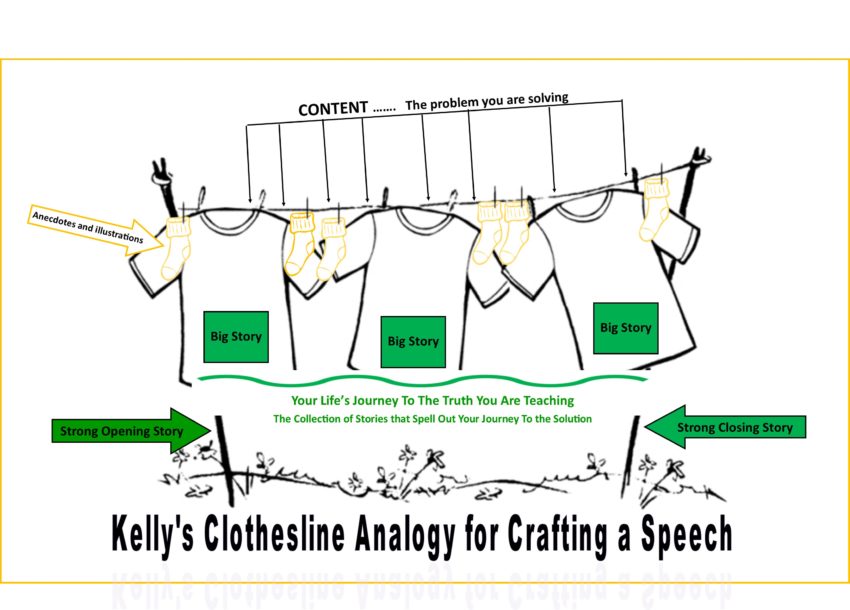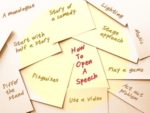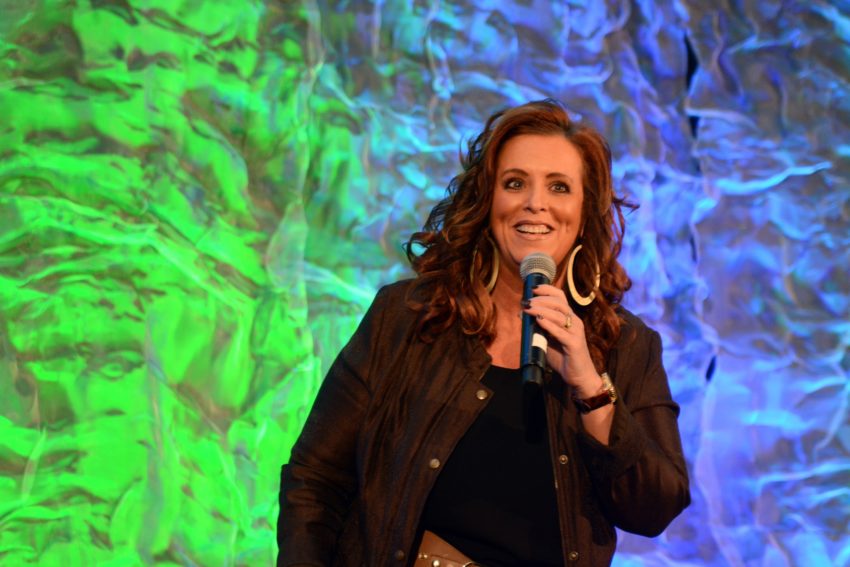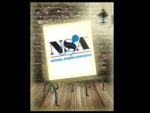Last updated on January 22nd, 2019 at 01:58 pm
How to Write a Great Speech
Believe it or not, writing a great speech is one of the most challenging aspects for most public speakers, but especially for those of you just starting out on your paid public speaker dream journey.
You’d think it’s taken as a given that a seasoned public speaker knows how to write an impressive speech, but I run into more orators who can’t develop a stunning speech, than orators who can.
If you are struggling every single time you sit down to create a speech, then hopefully my forthcoming advice here will help make your speechwriting process easier and offer clarity on what matters most in your speech.
Where Do You Start?
You start by understanding the anatomy of a speech and then planning it in outline form before you ever write the first word. You start by knowing what you will speak about and what message you are giving to the audience.
Before you write your speech, you must determine what you are teaching the audience to do, and why it matters to their life and their business. I call this the “Content” portion of your speech. Your content can be as detailed or as brief as you choose to make it.
Enter the Speech Content Template 9 Questions:
| 1. Who am I? | |
| 2. Why am I here? | |
| 3. What is the problem we all face? | |
| 4. What happens if we don't fix this problem? | |
| 5. How did I experience this problem in my own life/business? | |
| 6. What overall solution did I find? | |
| 7. What were 3 ways I solved this problem? | |
| 8. What were obstacles I faced on this journey and how did I address them? | |
| 9. How did my life/business get better once I solved this problem? | |
If you can’t answer the template questions, then you might just have a story and nothing else. Your story is not a speech. Your story is your story. A speech is something that teaches your audience.
Here’s the kicker. Are you ready?
Read carefully:
CONTENT IS NOT WHAT GETS SPEAKING GIGS OVER AND OVER.
It’s how you wrap your speech. It’s the story.
I can’t count how many speakers I hear teach you to focus on content. “You’re an expert who speaks!” they shout. I couldn’t disagree more.
Yes, you are an expert on something.
Yes, you speak.
But it’s not your content that gets you booked as a keynote speaker! It’s the way you deliver your content. Period. End of discussion.
THE EXPERIENCE GETS YOU BOOKED SPEAKING GIGS.
The content gives you credibility.
I recently attended my annual speaker’s convention where one speaker stole the show. Hands down, he was the best speaker I have ever heard. It was the best speech I have ever heard. And every person I ran into gushed about his speech. We can’t stop talking about his speech.
His name, by the way, is Mark Scharenbroich and his website is NiceBike.com and if you ever get the chance to hear him, do it. He is a real master.
• Fact: He gets booked. Over and over, and over, and over.
• Fact: Meeting planners rave about him as much as I do.
• Fact: Everybody isn’t raving about his content. In fact, when I ask people what his points are, they have trouble remembering. And they don’t care.
It wasn’t the content that got him booked or made him memorable. It was everything else. It was his stories, and his act-outs, and his improv, and his pulling someone up from the audience and referencing our group and a million other stunts that I have yet to uncover until I study the video–which I will, for the rest of my life.
As with any bold proclamation in the public speaking business, there is always more than one exception. So, yes, I’m sure you can name a few people who get public speaking bookings because they are the real expert (as in world-famous, not famous among their peers) on a subject. But the majority of keynote speakers are booked for the emotional experience they create for their audience.
How does content fit?
It needs to be there for the bookers to justify the speaker’s expense. No content and you’re just an entertainer. Bookers ensure your content is something they want for their event. But how you wrap your content will determine how much money you will make as a paid speaker in high demand. I promise!
Food for thought: I’ve seen audiences walk away with content that changed their life, but they don’t remember the speaker beyond lunchtime. You can’t afford for your audience’s only takeaway to be a new lesson. You need them to walk away singing your praises like raving fans at a rock concert.
When I coach public speakers, I focus on how I can help them create raving fans. These fans are why I spend very little time on content. I just want to make sure you have something to say, and that you can spell it out in a clear, concise way, so we can cross this part off to move on to what matters most in your speech presentation.
FOR EVERY MINUTE I SPEND ON CONTENT
I spend an hour on the story.
The Clothesline Analogy for Great Speeches
Disclaimer: This is a really BASIC format. The more advanced you get, the more you will start moving the pieces around–splitting stories–creating more story through lines, etc. But you have to start somewhere.
• The Clothesline
The actual Clothesline is the content of your speech. Notice how it’s a flat line? This flatness is because your content is, well, quite flat.
Content alone is boring and has NO impact; I don’t care how exciting you think it is. It is void of emotion. The line from left to right follows your argument–the template questions I gave you above to fill out. If you do handouts, this is probably the information you put on the handout.
• The Goal Posts
OK, so they’re not actual goal posts. It’s a clothesline for gosh sakes. I don’t think these posts have a technical term. But they are of major importance because they bookend your speech. The opening and closing moments are the two most important moments of a speech because they are what audiences remember the longest.
Make them strong and sturdy… and memorable.
Open with a bang and close with a bang. Never open with dribble (e.g., “I’d like to thank…”, “Isn’t this a nice room…?”) and never close with dribble (Question & Answer sessions).
Just as the success of a book relies on it’s opening the first page, so does your speech. Lose the audience now, and you may never get them back. Leave them at mediocre, and they will walk away relating your face and brand to mediocrity.
• The T-Shirts
“T-Shirts” is where the magic happens. It’s in every shirt you hang on your Clothesline. These are the stories–and by a story, I mean anything that illustrates your content in story-form. T-shirts can be an actual story, an act-out, a game, a monologue, a song, etc.
If you think your speech should have one nice, little emotional story at the end, you are mistaken. I recently heard a speech that was pure content (e.g., “here is what you need to do”) start-to-finish and the audience was sleeping with their eyes open. The speaker ended with a touching story, and in that few moments, the audience finally came to life. But it was too late. One cute story at the end can’t make up for thirty minutes of a data dump.
And there’s something else about a story you need to know:
CONTENT COMPELS.
But it’s the story that s-e-l-l-s.
As public speakers, you are also salespeople, even if you have nothing tangible your audiences can buy or sign-up to do. You are selling yourself on the stage. You are selling truth, and you need the crowd to buy-in. You are trying to impact and influence–to sell your message which makes you a salesperson.
The Cardinal Rule in sales is: People buy from people they like, believe, trust, and feel they know.
I hope you’re nodding your head. This selling-while-public-speaking truth isn’t simply me writing to test my keyboarding skills here–it’s sales 101.
Here’s what some of you are missing:
The data isn’t what makes you likable, believable, and trustworthy. It’s your story. Why choose the last moment of your speech to become my friend, to become real, to become human? You need to connect with your listeners first so that they will follow you on your speech journey. If you just dump data, you’re telling your audience what to do. And, guess what? People don’t like you telling them what to do. Verbally dumping data won’t give you credibility; your story does. Trust me. I see this play-out with every successful public speaker I study and every speaker who wishes they booked more keynote assignments.
YOUR SPEECH SUCCESS WILL BE IN DIRECT CORRELATION TO
how good the T-Shirts are on your Clothesline.
• The Socks
In your speeches, you have big stories (“T-Shirts”), and you have smaller anecdotes that don’t take as much time. They are usually the smaller stories illustrating your point and connecting the overall content of your speech. I call these smaller stories “The Socks.” Not every story in your speech has to be big; some stories are only small nuggets.
They are examples, perhaps not even scripted out too much. I’m a big believer in scripting a speech, but I will still leave moments open in “The Sock” area and content area for more unstructured conversation. Improving in the moment lets audiences know that you’re connecting with them by responding to the room.
Even in the content, I believe The Sock has the impact and brings your point home. Your “point” is simply driving a repeatable, retweetable line. I think every good teacher will agree that the real learning moment comes when the student sees (or experiences) the content as it applies to their life.
• The WOW Factor
You’ve got a good speech when you have a clear Clothesline, awesome posts at each end, interesting Socks, and off-the-hook T-Shirts. You can probably coast forever on this new you. But there’s another level, and I call it the WOW factor, and it has to do with a small, wavy line running through your Clothesline.
When I help speakers find their voice and tell their story, I’m looking for more than solid content and amazing T-Shirts. I’m looking for a thread running through the entire speech. This thread is a common theme or story that runs throughout your address. Most often, I find this thread to be your life’s journey on your way to the truth you now teach. Let me repeat it. It’s that important.
YOUR SPEECH IS YOUR LIFE’S JOURNEY
to the reality that you teach.
The reason bookers choose and hire a speaker is that particular speaker’s perspective on the world–the speaker’s story–their journey–their life from where they sit. If the possible attendees simply want information, they can buy the book or take a handout. Bookers hire a speaker to make information more personal to an audience.
When I’m looking at someone’s speech, and it’s a series of points hanging on to some good stories, I try to find something bigger, something more profound that makes the audience think WOW!
 Let me offer you an example.
Let me offer you an example.
I was working with a speaker, Theresa Rose, who has a fantastic talent. She Hula Hoops. Yes, you heard me right. She brings down the house with a Hula Hoop.
And as much as she might fight it, it’s not her content we want to see. We want to watch her Hula Hoop.
Yes, her content is essential. No denying that. But the Hula Hoop is what engages and entertains and keeps our attention.
The Hula Hoop sets her apart.
Her material is the same content others are giving, just told a different way. Audiences want the show. When I first met her, the Hula Hoop performance was at the end of her speech.
It worked, but I couldn’t help but think, “What if…”
What if the Hula Hoop was another character in her speech?
What if she had her personality?
What if she was a prop/persona that ran through the entire thing?
What if we named her Stella?
What if Theresa talked with Stella like she was a real person?
What if the Hula Hoop also became a part of each story?
What if she became a steering wheel or a clock?
What if she weaves the Hula Hoop seamlessly into every moment of her speech?
WOW. We both in one moment watched her good-enough speech become the most fantastic idea ever. That’s what I mean by the WOW Factor. And, by the way, the Hula Hoop is what helped her lose weight and change her life–it’s integral to her message.
Let me give you another example to show you how many ways you can find a WOW Factor:
I was chatting with Paul Templer about his speech and he has an amazing story about getting his arm chewed off by a hippo. I’m jealous of his story. Some speakers get all the luck. Anyway, we were going through his speech. The content was there. Check! The story was exciting. Check! But we wanted a WOW Factor.
story. Some speakers get all the luck. Anyway, we were going through his speech. The content was there. Check! The story was exciting. Check! But we wanted a WOW Factor.
I asked him what he wore on stage, and he said, “A suit.”
“Why are you wearing a suit?” I asked, “It doesn’t match the story. I want to see you wearing the safari guide uniform you wore that day. And I don’t want you to be a speaker on a stage in a suit telling me about it. I want you to relive it. I want you to be the guy in the bar swinging a beer with your leg up on a stool, and we’re all rallying around you as tell this wild tale. Wouldn’t it be cool if the stage were set up like a bar with a high table and bar stool and we, your audience, are listening to you tell the story? You can still give us content, just don’t break character. And wouldn’t it be cool if you have PowerPoint slides with the actual pictures from the river? Or even a video that makes us feel like we are going down the river with you at that very moment? And wouldn’t it be cool to have a smoke machine blow smoke through the stage?”
Okay, so the smoke machine was a little over the top. Or was it? Can you see in just this example how a speech can go from “strong” to “WOW”?
It doesn’t have to be that complicated. Sometimes it’s as simple as me helping you write your life story as it applies to the Clothesline. The moments in your life that led you to here.
When I was assisting a speaker friend of mine “find the WOW that is within her” we stumbled on her father and what a significant influence he was in her life, and how his story fit into hers. Before long, we came to see that the speech was really about her father and the impact he made on others. Her speech was on customer service. Bingo. We’ve taken a good speech and entered into the WOW Factor, by merely finding a storyline we can weave through the speech.
There’s nothing simple about telling one long story divided up by moments of content. It’s profound for the audience. When you drag a story out throughout the speech, you’re taking them into a movie, and they will hang on with you every step of the way because they are desperate to find out what happens next.
I can cite even more different examples of WOW Factors. But the main point I want you to see is that I want you to leave this article looking for your WOW Factor.
I hope by now you understand how little impact your content has, and how much your “T-Shirts” matter. I also hope you’ve gained clarity on how to write a genuinely fantastic speech. But more than anything, I hope you find the courage to take your public speaking to a WOW place–to uncover a new talent–to add a song or a prop–to spend the time on the T-Shirts that matter.
Now here’s your writing a great speech homework:
Whenever you go see a public speaker, write down what you like about their speech. Why is it impressive to you? Keep a list. And before long, you’ll see that I’m right about the Clothesline.
Cheers to writing your next great speech!
Kelly Swanson
Kelly Swanson is an award-winning storyteller, comedian, motivational speaker, Huffington Post Contributor, and cast member of The Fashion Hero television show airing on Amazon Prime. She is also the author of Who Hijacked My Fairy Tale, The Land of If Only, The Story Formula, and The Affirmation Journal for Positive Thinking. She was a featured entertainer for Holland America Cruise Lines, keynote speaker for the International Toastmasters Convention, and has keynoted major conferences and corporate events from coast to coast. She just launched her one-woman show Who Hijacked My Fairy Tale in theaters, and it is being booked all over the country. In July of 2022, she was inducted into the National Speakers Association Speaker Hall of Fame.
Note: Articles by Kelly may contain affiliate links and may be compensated if you make a purchase after clicking on an affiliate link.






